Hazardous environmental factors are really not anyone's idea of a fun topic, so I want to keep all the gory depressing medical details to a minimum and focus more on the technical challenges of monitoring and measuring these invisible quantities. There will be a separate blog for each hazard explaining why I want to measure it, but each of them will also cover methods of minimizing the risks and also the measurement techniques or circuitry I will be using. I am starting with sensors that need circuitry to be designed so I can get the PCB on order as soon as possible.
Ultraviolet Light
When people think of dangerous radiation, they don't usually think of light, but the most common adverse health effect due to radiation is sunburn - from ultraviolet light. Excessive UV exposure can also lead to skin cancer. UV radiation is divided into wavelength ranges identified as UVA (315 to 400 nm), UVB (280 to 315 nm), and UVC (100 to 280 nm).
UVC would probably be dangerous but it is so energetic it gets absorbed in the atmosphere and never reaches the planet surface.
About 5% of solar radiation is UVA. Of the solar UV energy reaching the equator, 95% is UVA and only 5% is UVB, but both can cause serious adverse effects. UVB can penetrate through the epidermis and UVA penetrates even deeper – through the dermis.
UV is dangerous to many living organisms and is often used to sterilize transparent liquids.
UV is both good and bad for people – it helps us synthesize the extremely important hormone called vitamin D, but can also damage DNA - leading to health problems such as sun burn, skin aging, cataracts and skin cancer. It also suppresses the immune system. In Canada there are over 80,000 cases of skin cancer diagnosed each year and over 1,000 Canadians die from skin cancer each year. Most (about 90%) are attributed to UV exposure and the case rate has been increasing for the past 2 decades.
It is fairly easy to avoid excessive UV exposure, but the perception appears to be that the risks are not significant.
UV exposure avoidance/minimization methods:
- stay indoors
- stay in the shade
- limit the time spent in the sun
- wear UV blocking glasses or sunglasses
- wear clothing that minimizes exposed skin
- install UV blocking windows
- use sunscreen compounds on the skin
- do not use electric lights that generate UV, such as fluorescent lights
- avoid tanning beds
- stay well hydrated when outdoors
- pay attention to the UV Index forecast
Those who try hard to avoid UV exposure should investigate whether vitamin D supplements are warranted – the literature seems to suggest they are necessary.
Sensor Technology
I will be using an ML8511 photodiode to measure ultraviolet light. It is easier to buy these sensors on a PCB so this is what I will buy:
This sensor has a spectral sensitivity that almost perfectly captures the UVA and UVB spectrum as shown here:
This next graph shows the sensor sensitivity to UV.
Below is a crude summary showing conversion between UV intensity and UV Index,
CIE-weighted irradiance (power density)
From \ To | Wm-2 (CIE) | Js-1m-2 (CIE) | UV-index |
Wm-2 (CIE) | 1 | 1 | 40 |
Js-1m-2 (CIE) | 1 | 1 | 40 |
UV-index | 1/40 | 1/40 | 1 |
Example: 75 mWm-2 CIE-weighted UV equals (75/1000)*40 = 3 on the UV-index scale.
If I am reading all these numbers correctly, it looks like this sensor is not ideally sensitive to the levels of UV in sunlight so the signal may need extra gain. I will use a general purpose offset and gain adjustment circuit to ensure I can get reasonable readings in normal sunlight. The Texas Instruments TLV4333 quad op-amp I am using is a nice accurate, low offset, low drift, rail-to-rail amplifier well suited to low speed sensors. This circuit will connect to one of the analog channels on the MSP_EXP432P401R.
This circuit will be one of 4 or 5 sensors on a custom booster pack I am designing.
I will probably tackle the other sensors on this booster pack next as I need to design the PCB and get it on order.
All links to blogs related to this project can be found in the first blog here:
Safe and Sound - Invisible Hazardous Environmental Factors Monitoring System - blog 1

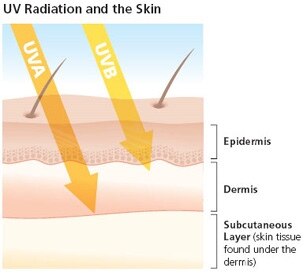
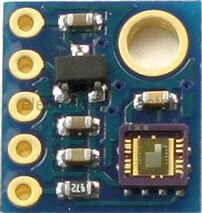
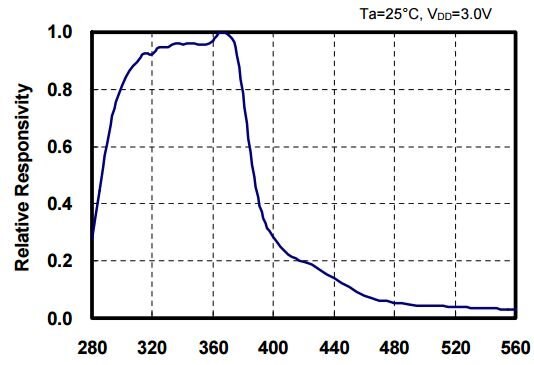
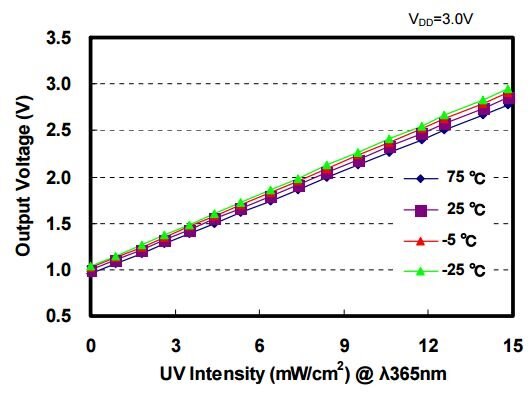
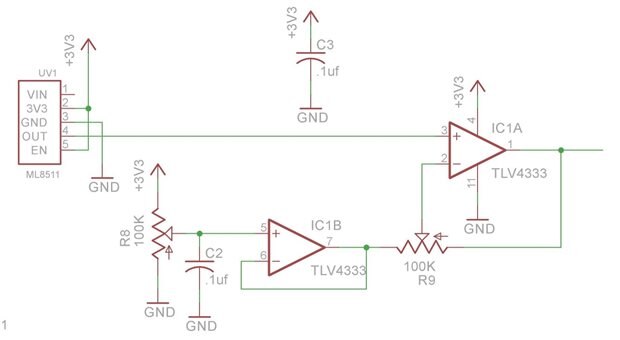
Top Comments
-

mcb1
-
Cancel
-
Vote Up
+2
Vote Down
-
-
Sign in to reply
-
More
-
Cancel
Comment-

mcb1
-
Cancel
-
Vote Up
+2
Vote Down
-
-
Sign in to reply
-
More
-
Cancel
Children